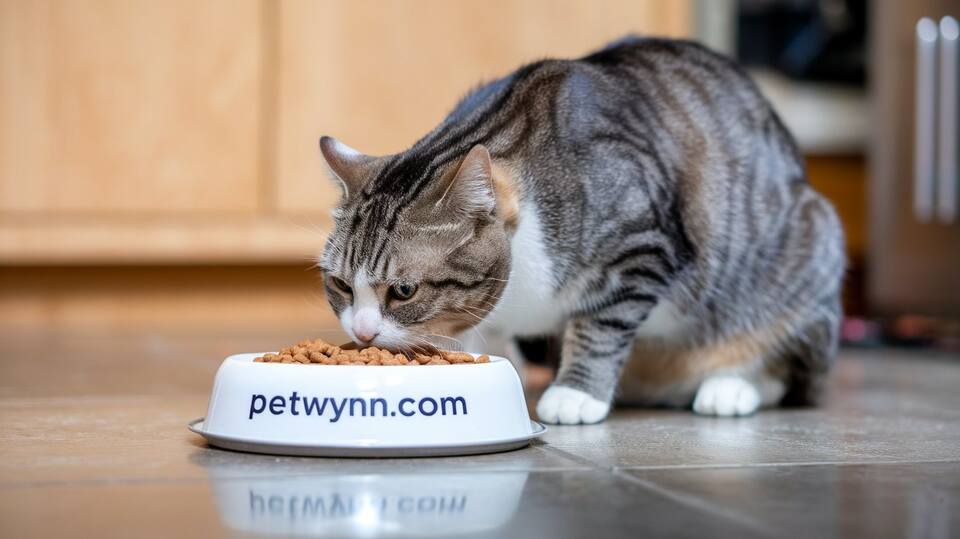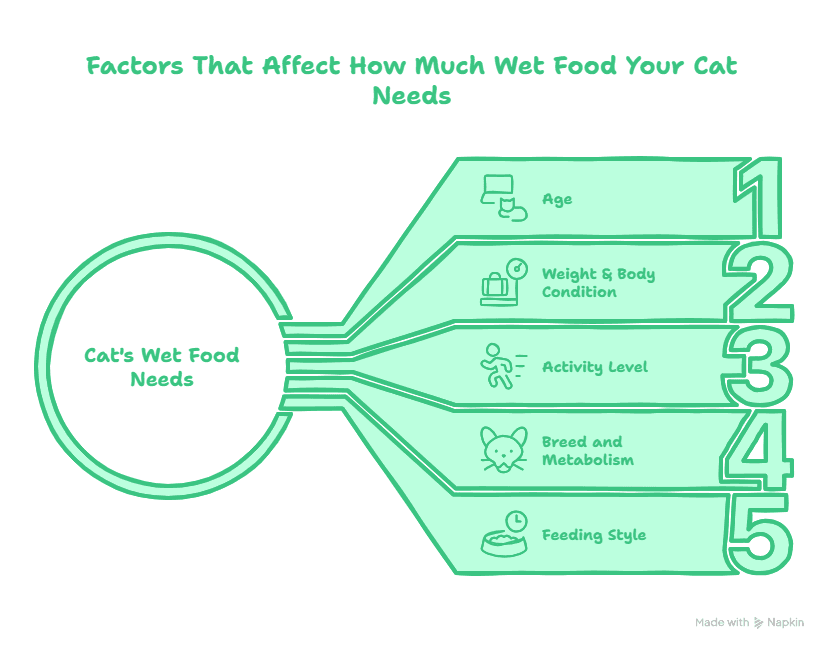
Introduction
Feeding your cat might seem like a simple task, until you realize there’s no one-size-fits-all answer. With so many types of food, serving sizes, and cat personalities to consider, it’s no wonder pet parents find themselves wondering:
“How much wet food should I feed my cat per day?”
Wet food is an excellent choice for hydration, nutrition, and overall health, but it also requires careful portioning to avoid underfeeding or overfeeding. Whether you’re feeding only wet food or combining it with dry, this guide will help you figure out the best daily amount for your unique feline friend.
Let’s dive into the science, the math, and the practical tips behind wet food feeding done right.
Why Wet Food Is a Great Choice for Cats
Before we calculate how much your cat should be eating, it’s worth understanding why wet food is often recommended, especially by vets.
✅ Hydration Boost
Cats evolved from desert-dwelling ancestors and naturally get much of their moisture from prey. Dry food contains only about 10% water, while wet food contains up to 75–80%, helping support:
- Kidney function
- Urinary tract health
- Digestive ease
✅ Closer to a Cat’s Natural Diet
Wet food is typically:
- Higher in animal-based protein
- Lower in carbohydrates
- Closer in texture and moisture to raw prey
This makes it more biologically appropriate, especially for carnivores like cats.
✅ Palatability & Digestibility
Most cats prefer the aroma and texture of wet food, especially:
- Picky eaters
- Older cats with dental issues
- Cats recovering from illness
Factors That Affect How Much Wet Food Your Cat Needs

No two cats are alike. The ideal daily amount of wet food depends on several key factors:
🐱 1. Age
- Kittens need more calories for growth
- Adults need maintenance calories
- Seniors may need fewer calories but more digestible food
⚖️ 2. Weight & Body Condition
- A 5-pound cat needs far fewer calories than a 15-pound cat
- Overweight cats require calorie restriction
- Underweight cats need extra energy and nutrition
🏃 3. Activity Level
- Indoor cats burn fewer calories than outdoor or highly active cats
- Playful, high-energy cats may need more food despite smaller size
🧬 4. Breed and Metabolism
- Some breeds (e.g., Siamese) have faster metabolisms
- Others (e.g., Persian) are more sedentary by nature
🍽️ 5. Feeding Style
Are you feeding only wet food, or are you mixing it with dry? If you’re offering a combo, portions should be adjusted to avoid overfeeding.
General Wet Food Feeding Guidelines (By Life Stage)
Let’s break down approximate serving sizes based on your cat’s age and weight. These are general estimates and should always be adjusted based on your cat’s condition and activity.
🍼 Kittens (0–12 Months)
- Need more calories per pound due to rapid growth
- Feed 3–4 meals per day
- General rule: 1 oz of wet food per pound of body weight per day
Example:
A 2-month-old kitten weighing 3 lbs might need 3 oz/day, split into multiple feedings.
🐾 Adult Cats (1–7 Years)
- Require around 20–25 calories per pound of body weight
- Most wet cat food contains 70–100 calories per 3 oz can
So, a 10-pound adult cat needs 200–250 calories/day, which is about:
- Two 5.5 oz cans or
- Three 3 oz cans, depending on the brand
Split this into 2–3 meals/day to align with their natural grazing behavior.
👵 Senior Cats (7+ Years)
- May have slower metabolism or specific health issues
- Wet food is easier to chew and digest
- Monitor body condition more than just weight, seniors are prone to muscle loss
Your vet might recommend higher protein wet food or adjustments for chronic conditions like kidney disease or arthritis.
How to Read Wet Food Labels for Portioning
Here’s how to decode the label like a pro:
🥫 Look For:
- Caloric content (e.g., “95 kcal/can”)
- Feeding guidelines (based on weight or life stage)
- “Complete and balanced” statement (meets AAFCO nutritional standards)
Some cans recommend feeding based on weight:
“Feed 1 can per 3 lbs of body weight daily.”
If your cat is 9 lbs, that means 3 cans/day of that brand.
⚠️ Keep in mind that feeding guides are starting points, not exact prescriptions. Always monitor your cat’s body condition and adjust accordingly.
Sample Feeding Chart Based on Cat Weight
| Cat’s Weight | Calories Needed Daily | Approx. Wet Food (3 oz cans) | Notes |
| 5 lbs | 120–140 kcal | ~1.5–2 cans | Small, low-activity cats |
| 8 lbs | 160–200 kcal | ~2–2.5 cans | Average indoor cat |
| 10 lbs | 200–250 kcal | ~2.5–3 cans | Adult, moderately active |
| 12–15 lbs | 250–300+ kcal | ~3–4 cans | Larger or high-energy cats |
➡️ Adjust if feeding dry food alongside wet—reduce accordingly to stay within caloric needs.
Wet Food-Only vs. Mixed Feeding
Wondering if you should combine wet and dry? You can! Here’s how:
🥣 Wet Food-Only Feeding
- Best for hydration
- Great for picky eaters or cats with dental issues
- Requires multiple daily servings (2–3 feedings)
🍗 Mixed Feeding Plan
- Wet-food in the morning and evening
- Dry food during the day (measured portions!)
- Helps with dental texture and food variety
If using both:
- Cut wet food portions in half and fill the gap with dry
- Keep total daily calories within target range
How to Know If You’re Feeding the Right Amount
No label can tell you exactly what your cat needs. Watch your cat’s body and behavior for clues.
✅ Signs You’re Feeding the Right Amount:
- Stable weight
- Sleek body, slight tummy tuck
- Bright eyes, smooth coat
- Healthy appetite without begging or over-gorging
🚫 Signs You May Be Overfeeding:
- Sudden weight gain
- Lethargy, less play
- Loose or smelly stools
- Food left in the bowl
⚠️ Signs You May Be Underfeeding:
- Rib visibility, spine prominence
- Constant meowing or searching for food
- Weight loss or low energy
- Dull, dry coat
Track weight monthly and adjust by +/- 0.5 oz per meal if needed.
Helpful Tools for Accurate Feeding
A few simple tools can help you become a feeding pro:
🧪 1. Digital Pet Scale
- Weigh your cat regularly (monthly)
- Monitor for subtle gains or losses
🥄 2. Kitchen Scale or Measuring Spoons
- Helps portion wet food precisely
- Useful when splitting cans over several meals
⏱️ 3. Scheduled Feedings or Timers
- Keeps you consistent
- Prevents overfeeding due to random snacks
🤖 4. Smart Feeders for Wet-Food
- Some models now support portion-controlled wet food feeding
- Ideal for busy cat parents with set routines
When to Talk to Your Vet About Feeding
A quick chat with your vet can go a long way, especially if your cat is:
- Overweight or obese
- Losing weight unexpectedly
- Diagnosed with chronic illness (e.g., diabetes, kidney disease)
- Experiencing digestive upset, vomiting, or appetite changes
Your vet may suggest:
- Prescription wet food
- Specific feeding amounts or nutrient ratios
- Transition plans for dietary changes
FAQs
Can I leave wet food out all day?
No. Wet food spoils quickly (within 1–2 hours at room temperature). Always refrigerate unused portions and discard uneaten food after meals.
How often should I feed wet food per day?
Split daily portions into 2–3 meals, ideally morning and evening. Kittens may need more frequent meals.
Can I mix different brands of wet food?
Yes, as long as they’re all complete and balanced. Mix gradually to prevent digestive upset.
Is wet food better than dry food?
Both have pros and cons. Wet food is better for hydration and palatability; dry is easier for free-feeding and often cheaper. Many vets recommend a mix of both.
Should I warm up wet food from the fridge?
Cats usually prefer room temperature food. You can warm it slightly (NOT hot) using warm water or 5–10 seconds in the microwave. Stir well and test before serving.
Also Read - How to Stop a Cat from Begging for Food? Practical Tips for a Peaceful Mealtime
Conclusion
So, how much wet food should you feed your cat per day?
It depends, but you now have the tools to figure it out:
- Consider your cat’s age, weight, and lifestyle
- Read labels and monitor calories
- Use feeding charts and visual cues to fine-tune portions
- When in doubt, talk to your vet
With consistent care and proper portioning, wet food can support your cat’s hydration, health, and happiness, one delicious bite at a time.




